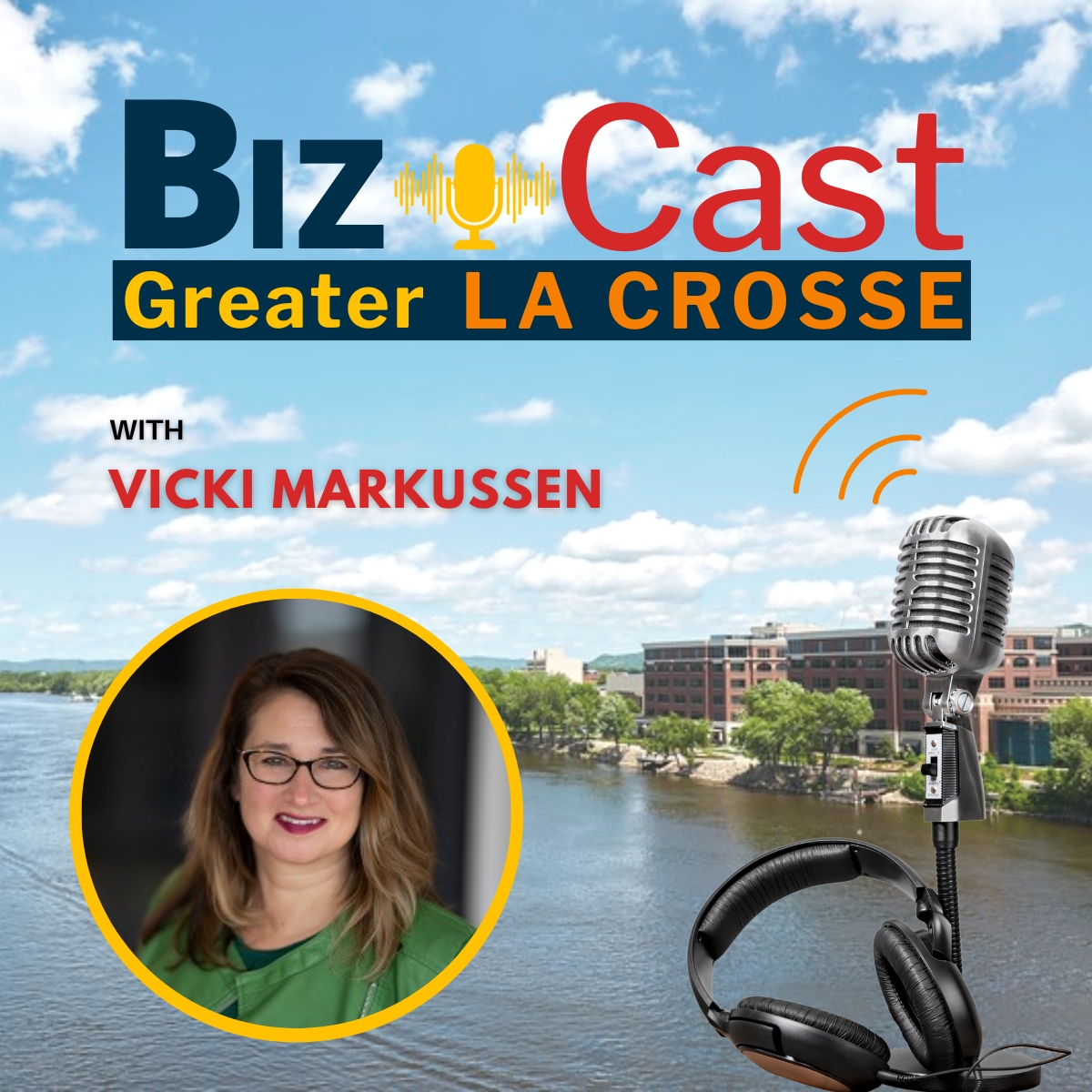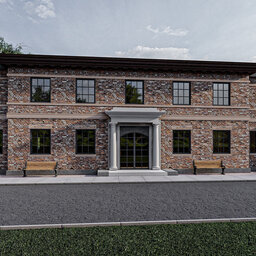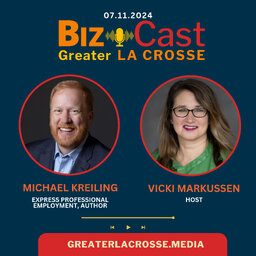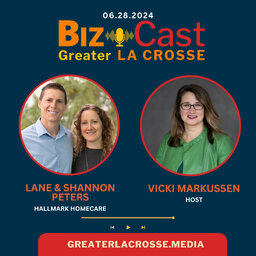
Episode 23
La Crosse Park & Rec Director Odegaard on Fish Hatchery & Pearl Street Walkway
About BizCast Greater La Crosse
We bring you news from the business community. From startups to experienced problem solvers, you’ll get in-depth insight on the challenges and opportunities of doing business in Greater La Crosse. Our show is a collaboration between WIZMNews.com and BizNews Greater La Crosse ( GreaterLaCrosse.media ).
Full Transcript [ generated by AI]
Jay Odegaard 0:04
What does the community need? What is the community want?
Then that’s really what drives these partnerships.
Vicki Markussen 0:14
Welcome to BizCast Greater La Crosse. I’m your host, Vicki Markussen. This is brought to you by business news, greater La Crosse. We bring you news out of the business community. And joining me today is Jay Odegard. And I got a chuckle, as I said, is your title still director of Parks and Recreation? And he said, and forest and grounds forestry and gown grounds and the La Crosse Center, they have a whole list of other things to talk about. La Crosse center to me is one of those right? So people, the taxpayers look at it like what fun thing is there for me to do at the La Crosse Center. But what happens quietly, are conventions and meetings and weddings and all kinds of things that aren’t necessarily seen by the public. And so let’s start with the big topic of La Crosse Center, which is there was consideration of an outside company managing the La Crosse Center. And that decision has been made not to do that correct. Can you talk about that?
Jay Odegaard 1:13
Well, right now, you know, what we have done through the request for proposals. Process is found some very unique and innovative ways to use contract service in certain areas to recruit, decrease costs and increase efficiency. And so I think that was a that was a very positive outcome from that process. You know, in short, we have a $43 million addition to the La Crosse Center. And that tied in with the COVID has created a situation where we’re still learning, we’re still figuring out what is this building, we’re growing into the skin so to speak, we there’s a tremendous difference between the, what the building was to what the building is now. I mean, it’s doubled in square footage. It’s the shiny new toy and and I think one of the things that I overseeing a lot of other municipal facilities are concerned with is keeping it the shiny new thing, right. So deferred maintenance, upkeep, those types of aspects of owning property are sometimes lost. And so we’re really making a conscious effort to continue that. I think, you know, with with the La Crosse Center, I use an analogy that if I find an old baseball card in my closet, I’m not going to sell that card until I know what it’s worth. And so that’s really my driving reason for holding off on the contract management. You know, and as of right now, in the in the month of April, we had two open dates. And that was Easter and the Monday after Easter in the La Crosse Center. So you’re definitely right. I mean when we look at like the concerts that that are what people talk about, and they’re what the local community likes to attend. Really, that what drives that, that machine down there is the conventions and the weddings. Those are the activities that are putting in all the heads and beds. Those are the activities where people are staying overnight and they’re continuing to invest in the city of La Crosse. Most of our concerts while we don’t work we try to do as many as we can. They’re more of a you know, drive to the concert and drive home. And so we really try to find that you know that that ratio that serves everybody else. The other thing with these weddings and and the conventions is not only is it something that benefits the La Crosse Center and the hotels but it also generally relates to then a large amount of catering which is you know really a big business here and La Crosse with all the tourism.
Vicki Markussen 4:40
Absolutely. And I know talking to businesses they said the lights went from dim to bright the second the La Crosse Center started hosting events again of any sort, right whether those are our conventions and conferences that most of us don’t have impact with to the events but people fill the restaurants people go about shopping. And so that was, I guess if there’s one benefit to the pandemic, it reinforced the value of some of these things La Crosse Center was built to help feed traffic to the downtown at the time that the mall opened up and everyone was afraid of what was going to happen. And so it reinforces those those pieces and I think you’d probably agree with it to the conferences are still trying to figure out what’s the future of conferences and I know having, having had many people say, Hey, can we host this conference in La Crosse, everyone loves to come to La Crosse, because it’s beautiful. Our historic downtown and kind of gets back to that conversation of the things we take for granted. Like I always say, the places where people love to live are also the places that the tourists like to come to. One of the enhancements happening downtown are trees. So a lot of people have said if we want to look at the heat levels, if you will, of downtown, how do we start looking at canopies. It’s been challenging, people have seen trees come and go, what’s the current status of trees downtown? Well, one
Jay Odegaard 6:06
of the things that we have struggled with over the years is survival rates of these trees, when we put a tree downtown, generally surrounded by concrete, soils all compacted, you know, due to the roads and the buildings, you know, we’re looking at maybe three to five years that that tree will last. So what we what we’re doing now, and this is largely driven by the ARPA funding that we received federally is putting in there actually like cells like bio cells that are underneath the ground that will allow that tree root to flourish. So we hired seh, to come in and assist in the design and the building of the specs on that. We’re hoping that that project will be done here this fall, we’re looking at probably around 80 trees that will be added to the downtown, the number of trees really isn’t as significant as what we believe the length of their life will be I mean, how that’s going to translate is going to be tremendous, you know, I tree, the tree canopy is something that oftentimes gets discussed as you know, cooling, bringing that cooling ability to a downtown. I personally like walking through a downtown that has green right and, and that’s that’s a big benefit. But you know, we’re also just getting underway with construction on the Pearl Street walkway. And, you know, a lot of this is all that additional aesthetic newness that we want to bring to the downtown area, really all over La Crosse, but to the downtown area. And again, it really just parlays very well with the number of businesses that that kind of cater to that food beverage entertainment, and is what makes it all across such a welcoming place for out of towners.
Vicki Markussen 8:18
Yeah. So the Pearl Street walkway is similar to is that main street that has the La Crosse players and the French statue if you will, that that connects to the river. This one would be at the end of Pearl Street between the La Crosse Center and the Radisson Correct. Is that green space? What let’s plan for that.
Jay Odegaard 8:36
It’s kind of a more of a natural meandering concrete pathway. There are some paver bricks in there. There’s also benches, trees, shrubbery, you know, it’s there’s going to be some decorative like signage. So it it’s just a very, it’ll be a very welcoming thoroughfare from downtown to the Mississippi River. You know, like, I think again, a lot of times we take this stuff for granted, but if you can imagine walking down Third Street and literally two blocks away, you can be in Riverside Park, you know, enjoying a Viking cruise ship sitting in front of you on the river. I mean, that’s, that’s pretty spectacular.
Vicki Markussen 9:23
Yeah. And it kind of gets to the desirability of living downtown as well as just having that walk that walkability that connectivity, and that’s actually a good transition to one other project, the fish hatchery, so named after what used to be the fish hatchery that became tourism, and now it’s called the hatchery. And what’s the progress though, for everybody’s body of knowledge that’s on the north side of Riverside Park, and it’s the amazing brick building that’s been worked on for a good year. Now. What’s the status?
Jay Odegaard 9:56
Well, you know that that’s a great example of another facilities city owned facility that, you know, maybe hadn’t been taken care of and kept up. And, you know, so we reach a point where, especially with these historic buildings that, you know, replacement isn’t an option. So it’s either removal, or it’s find a funding source to kind of renovate it back to a usable air, you know, usable building, and then how does that benefit the community. So, you know, with the hatchery, one of the things that we really wanted to do is kind of recapture the beauty of that, you know, building while at the same time, making sure that somehow it was tied into offering that amenity to parcours. And so the hatchery, you know, focusing on ice cream sales, and, you know, smaller cocktail parties and sandwiches and pop up coffee shops, and that obviously, having a small number of Airbnb units, you know, those are things that are going to greatly benefit parcours in turn private funding, fixes the building keeps it, you know, occupied. And so, to me, it’s a win win. And those are kind of those newer ideas that I think you know, you the public, we’ll be seeing more of in the future.
Vicki Markussen 11:33
And I think the piece that gets missed, and you know, this very well of, it’s a fine line between what you charge those companies for rent, right, because they don’t own the building. And a historic building is incredibly expensive to renovate. That’s why the city didn’t do it, right. And so it’s a partnership. And so in that partnership, you really like those owners, I know those two owners are trying to make those numbers work and go, how much can we spend on fixing up this building and recoup through Airbnbs and through the shops, because they’re not gonna have a consistent shop down there, which is risky of are they gonna have the income. So you have to balance their risk with not trying to price them out of making that project happen. And so that’s not always easy to navigate. I know. So how. And I think you guys take I think you’d agree with this. You take a lot of criticism for your new philosophy, which is how do we have more of these partnerships, as opposed to the taxpayers taking it all on?
Jay Odegaard 12:35
Yeah, I mean, yeah, there’s definitely criticism. But I truly believe and if you look at some of the partnerships we have created, whether it be my rec center, and whisk core, or the loggers and Copeland Park, or the petty bone ballclub, on and on and on, it’s a win win. And not only a win for the city, but a win for the entrepreneur, and also a win for the community. Each one of these, you know, Partnerships has based off of what is the need? How is this addressing a need? It’s not about the money, necessarily. I mean, the money is, you know, the evil necessary. But when we look at what is the community need, what is the community want. And that’s really what drives these partnerships. And as the city representative, I feel that it’s extremely important for us to be there for our partners. So when we talk about these investments, and is it going to work, we want to make sure that we are building a plan and building a lease structure that’s going to make it possible for that entrepreneur to assist succeed. We don’t want to, you know, paint them into a corner. Because if they fail, ultimately we all fail. And so that’s that’s one of the kind of big aspects that I try to relate when I get those concerns shared with me.
Vicki Markussen 14:19
Yeah, and let’s just use that one at the hatchery as an example. So you may let’s just say have lower than market rent for what people see is the value of that building. But in the end, you now have a probably million dollar plus building that the city technically owns. So while we all want that business to be successful, and those are two local people that I want to see be successful. In the end, you are the landlord, you’re the property owner. So that is a bonus, if you will. So speaking of assets, trails, I mean, we all saw Thank goodness for the expansion of the trails that happened up by granddad there At the time that it happened, because the amount of people out on trails these days is crazy. What is what have you seen for numbers? What’s being planned? What does that look like?
Jay Odegaard 15:13
Well, honestly, we don’t have a real good measuring tool to get exact numbers. But we can see that, you know, the trail trail use has skyrocketed. The addition of additional trail heads, so to speak, has greatly helped in dispersing, you know, lower Hickson forever was where everybody went, and they were parked all the way back to bluff paths road. You know, when I, when I look at the trail system here, I really look at two different aspects. One is, you know, the hundreds of miles of trails for hiking and biking that we have up in the bluffs, you know, in our addition of some very quality mountain biking trails is probably what drives the most people from out of town to the area, and also increases the number of large events like the wars race, or the Hickson 50. But something that often gets lost is the trails in town. And those are just an remarkable connectivity. For the north side, the south side, even on Alaska, I was at my son’s track meet up in not Alaska the other day, and I ran into a couple of people that had traveled from the south side of the cross to Alaska highschool by the bike trail, you know, and so as these trails are far more utilized than what a lot of people realize. And when we talk trails, everybody immediately thinks of the bluffs. But, you know, the miles and miles of trails that people use for commuting is really remarkable. And it really leads us to, again, another expense that we have to make sure that we maintain these trails. And, you know, when we have these big floods, a lot of times there’s damage, but again, that’s where we have really focused on different federal and state grant opportunities. And we did just receive a, you know, a $500,000, tap grant from the D O. T, to redo a couple of the culverts and the trails in the marsh. And, you know, it’s just again, that constant search for, okay, what’s the need? And then how are we paying for it.
Vicki Markussen 17:47
And interestingly, as you’re talking, I’m thinking about, thank goodness, we have the outdoor recreation Alliance, now that’s helping with a lot of that, and they’re adding in the new trail system that they set off at 33. And so some of this becomes, at what point? Is there a capacity, right, so you talk about, the fewer trails you have, the more congested and I guess is a way to think of it? And then it’s a sad question to ask, and I don’t want to ask it, but how much do we need? And how much can we maintain starts to become like roadway, right. So you end up needing deferred, you have deferred maintenance on trails, too.
Jay Odegaard 18:24
Yeah. And that, you know, yes, how much? How much do we need is, you know, arbitrary, so to speak. But when we look at, you know, how much can we maintain, and that’s really the important kind of piece to this, because every time a storm comes, you know, there’s trees down over the trails, or the trails need to be weedwacker mode. You know, there is maintenance that is involved in it. So, really, that’s something that I think we focus on across the board is with these projects is Yeah, can we find the money to build this park is one thing, can we find the money to build the park yet still operate and maintain the park? And that is, that is something that I think, you know, the city of La Crosse is taking a good hard look at. Again, it’s great to build the shiny new thing, but you know, then you need to be able to keep it as a shiny new thing,
Vicki Markussen 19:25
right. And even if you get the private donations from outside, like a partnership, the maintenance always comes down to you guys. And so understandably, I think the community’s getting wiser to saying okay, that’s an understandable concern of you know, we’ll go raise the money but we do understand there’s a maintenance piece to it. You’ve been listening to Jay Odegard with the city park and rec forestry grounds, La Crosse Center, we covered a lot. You’ve been listening to him on Biz Cast Greater La Crosse. I’m your host Vicki Markussen. We’ll catch us wherever you listen to your podcasts and we’ll catch you next week





